Hamilton’s Vibrant Night Life
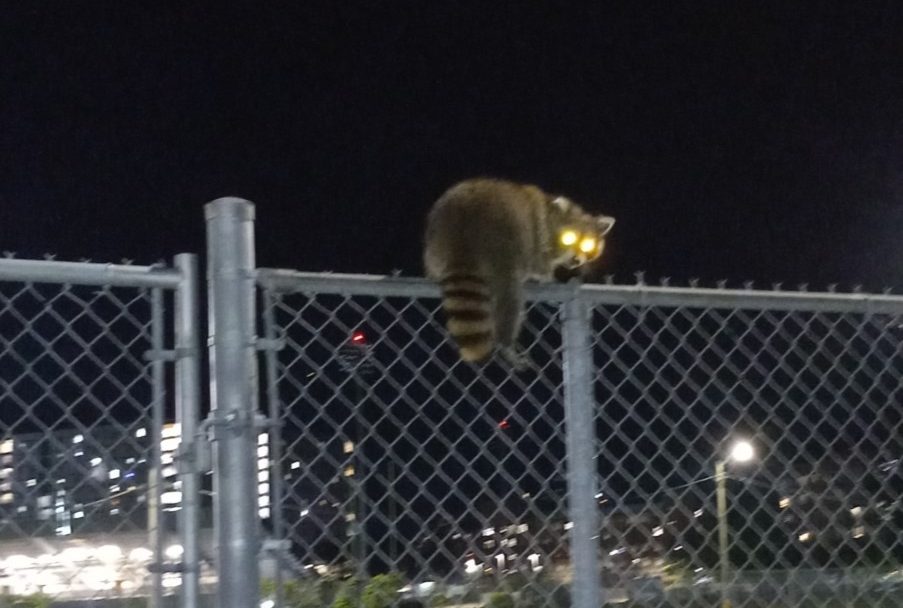
Humans, like many species, are diurnal. This means that we are most active during daylight hours, and spend the night sleeping. Many other recognizable species, like squirrels or pigeons, share our preference for the daytime. However, many species are much more active at night. These species can often be overlooked, since they are less likely to be encountered by people going about their daily activities. This article will discuss some of these fascinating species that can be found in the Hamilton area, and their important ecological roles.
Beautiful Bats
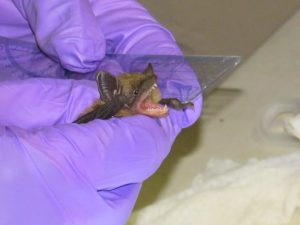
On midsummer evenings, look up at the sky and you may see dark silhouettes fluttering above you, chasing after insects. Alongside some nocturnal bird species, bats are important predators of nocturnal insects like moths and mosquitoes. In Hamilton, the most common bat species is the big brown bat. These large bats are more tolerant of human disturbance, and will even make use of buildings and other artificial structures as roosting sites. While this species has a healthier population than many other bat species, it is still susceptible to white-nose syndrome, a disease that is devastating bat populations across the globe. White-nose syndrome causes bats to wake up mid-hibernation, expending their energy and putting them at risk of starvation or freezing to death. Fortunately, organizations across North America are working to protect bats. You can help our local bats by planting native plants in your garden to boost native insect populations, and building bat boxes (Bat Conservation, 2023; NCC, Big Brown Bat).
Raccoons, Skunks, Opossums, oh my!
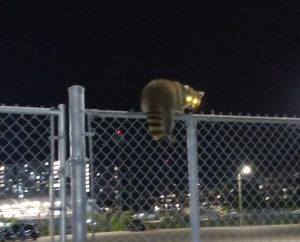
Human activities have drastically changed ecosystems across North America. While these changes cause population declines for most species, there are some species that have adapted particularly well to urban living. Many of these species are nocturnal, allowing them to avoid interactions with humans. These include some of the most common urban mammals, such as raccoons, skunks, and opossums.
Raccoons (Procyon lotor) are highly adaptable omnivorous mammals. They happily feed on a wide variety of food sources, including live prey (such as rodents and frogs), vegetable matter, fruits, berries, and any human food they can access. Raccoons are often considered pests in urban areas for their propensity to break into garbage bins and compost piles, and can be a vector for rabies (Lariviere, 2024). However, their presence in urban areas increases urban biodiversity, and demonstrates the interconnectedness of the human and natural worlds.
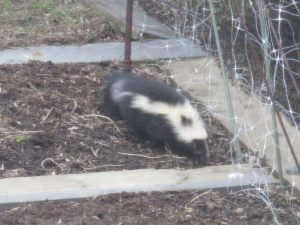
The only skunk species found in Hamilton is the striped skunk (Mephitis mephitis), a widespread species found across North America. Like raccoons, their omnivorous diet and nocturnal behaviour has allowed them to successfully thrive in urban environments. They feed on plant material, eggs, insects, small mammals, and any human food they can find. Striped skunks are well-known for their defense strategy of spraying a strong-smelling musk when they feel threatened (NCC, Striped Skunk). Striped skunks can also be a vector for rabies (Johnson et al., 2021). Due to the risk of rabies and of being sprayed with musk, skunks should be avoided when encountered.
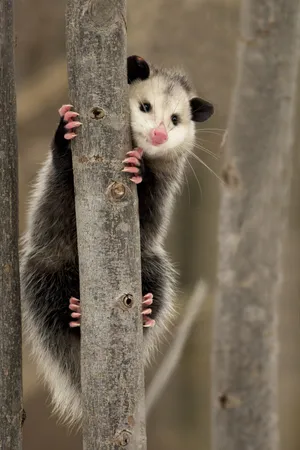
Virginia opossums (Didelphis virginiana) are a unique mammal, as they are the only marsupial found in the United States and Canada. Being marsupials, their offspring begin their lives in their mother’s pouch, and continue to hang onto their mothers until they are fully independent. Similarly to the previously mentioned species, Virginia opossums are opportunistic omnivores, feeding on anything they can catch or scavenge. This includes eggs, insects, fruit, small mammals, and human food. Virginia opossums are also skilled climbers, able to scale trees and buildings in search of food or shelter. Another unique trait of the Virginia opossum is their ability to “play possum”. When threatened without a viable escape route, Virginia opossums may go into a catatonic state where they become functionally unconscious. This behaviour allows them to deter predators, whose hunting instincts may be disrupted. Virginia opossums are a short-lived species, with the oldest documented wild individual being only three years old (Gardner, 2024). Opossums are unlikely to carry rabies, as their body temperature does not support the virus (The Humane Society of the United States). However, these animals should still be respected and given a safe distance when encountered.
Magnificent Moths

Moths are well-known, but often overlooked, nocturnal insects. While most people appreciate the aesthetic beauty of butterflies and their role as pollinators, their nocturnal relatives are rarely appreciated. However, some moths can match or even outdo butterflies when it comes to colourful presentations, and their ecological importance is becoming increasingly emphasized by researchers. Moths play a variety of ecological roles, from pollination to bird food. Moths, as night-time pollinators, fill an important niche that bees and butterflies do not contribute to (U.S. Forest Service). Moths also contribute as long-distance pollinators, and based on the sheer diversity of moth species and the plants they interact with their pollination contributions are likely significant. Overall, moth pollination is an understudied area, since nocturnal pollination and moths in general have been widely overlooked (Hahn & Brühl, 2016). Moths are also important food sources for a variety of species. Caterpillars are crucial protein sources for young birds, and the majority of these caterpillars are the larvae of moth species. Moths are also important prey for bats, nocturnal birds, spiders, and amphibians. Moths are threatened by a variety of human disturbances, including habitat loss and pesticide use (Butterfly Conservation). You can help our native moth species by planting native plants and avoiding the use of insecticides. Overall, moths are essential components of healthy ecosystems worldwide, and deserve as much (if not more) attention as their diurnal relatives.
Fireflies
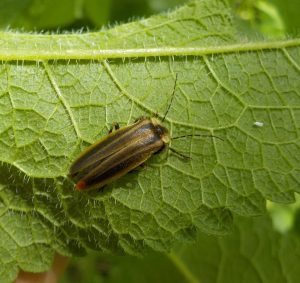
Fireflies are fascinating beetles in the family Lampyridae. There are 19 firefly species found in Ontario. Fireflies are typically black or brown beetles with yellow or orange on their elytra (shells). Firefly larvae are voracious predators, feeding on a variety of other arthropods including worms, slugs, and other insect larvae. As adults, fireflies may feed on nectar, pollen, other fireflies, or be incapable of eating altogether. The distinctive glowing that fireflies are known for is a mating behaviour, and both males and females engage in it to locate each other. Firefly glowing is a form of bioluminescence, produced in special organs in the abdomens of adult fireflies when the enzyme luciferase interacts with luciferin, oxygen, and an energy source. Different firefly species produce different colours, flash with different patterns, and exhibit different behaviours while glowing. Some female fireflies in the genus Photuris even use bioluminescence to attract males of other species to prey on them. While not all fireflies use bioluminescence as adults, all fireflies have bioluminescent larvae. This bioluminescence helps to deter predators. Unfortunately, many firefly species are declining. Like many other insects, fireflies are affected by human disturbance, including habitat loss and pesticide use. Leaf litter provides crucial habitat for fireflies to shelter in, so clearing leaf litter can unintentionally eliminate firefly populations. You can help your local fireflies by planting native species, leaving leaf litter in your yard, and avoiding insecticide use (Stefan, 2024).
References:
2023 state of the Bats Report. Bat Conservation. (2023, May 17). https://digital.batcon.org/state-of-the-bats-report/2023-report/
Butterfly Conservation. (n.d.). Why moths matter. Butterfly Conservation. https://butterfly-conservation.org/moths/why-moths-matter
Gardner, A. L. (2024, May 17). Virginia opossum. Encyclopedia Britannica. https://www.britannica.com/animal/Virginia-opossum
Hahn, M., & Brühl, C. A. (2016). The secret pollinators: An overview of moth pollination with a focus on Europe and North America. Arthropod-Plant Interactions, 10(1), 21–28. https://doi.org/10.1007/s11829-016-9414-3
Johnson, S. R., Slate, D., Nelson, K. M., Davis, A. J., Mills, S. A., Forbes, J. T., VerCauteren, K. C., Gilbert, A. T., & Chipman, R. B. (2021). Serological responses of raccoons and striped skunks to Ontario rabies vaccine bait in West Virginia during 2012–2016. Viruses, 13(2), 157. https://doi.org/10.3390/v13020157
Lariviere, S. (2024, April 5). raccoon. Encyclopedia Britannica. https://www.britannica.com/animal/raccoon
Lasenby, B. (n.d.). Virginia opossum. Encyclopædia Britannica. Encyclopædia Britannica. Retrieved August 6, 2024, from https://www.britannica.com/animal/Virginia-opossum#/media/1/128558/240909.
Nature Conservancy Canada. (n.d.) .Big brown bat. NCC. https://www.natureconservancy.ca/en/what-we-do/resource-centre/featured-species/mammals/big-brown-bat.html
Nature Conservancy Canada. (n.d.). Striped skunk. NCC. https://www.natureconservancy.ca/en/what-we-do/resource-centre/featured-species/mammals/striped-skunk.html
Stefan, A. (2024, May 21). Firefly. The Canadian Encyclopedia. https://www.thecanadianencyclopedia.ca/en/article/firefly
The Humane Society of the United States. (n.d.). What to do about opossums. The Humane Society of the United States. https://www.humanesociety.org/resources/what-do-about-opossums
U.S. Forest Service. (n.d.). Moth Pollination. U.S. Forest Service. https://www.fs.usda.gov/wildflowers/pollinators/animals/moths.shtml
Education, Nature Stories, Uncategorized